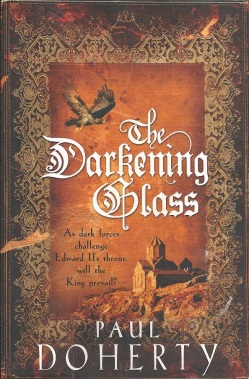 March 1312, England. Edward II is virtually at war with his Earls. They have hounded him out of London to take refuge in Yorkshire. The earls’ primary demand is that Piers Gaveston, Edward’s favourite and seen to be a blight on the throne, is removed – peacefully or by less subtle measures. As the King’s party take refuge in a fortified priory in Tynemouth, with the earls approaching from the south and Robert the Bruce approaching from the north, the last thing you want is a viper at your bosom. But Gaveston’s bodyguards, the Aquilae Petri, literally Peter’s Eagles, are dying one by one. It seems that one by one, someone is trying to teach them how to fly by hurling them off of towers to the hard stone below… someone who can overcome trained soldiers without any sign of a struggle.
March 1312, England. Edward II is virtually at war with his Earls. They have hounded him out of London to take refuge in Yorkshire. The earls’ primary demand is that Piers Gaveston, Edward’s favourite and seen to be a blight on the throne, is removed – peacefully or by less subtle measures. As the King’s party take refuge in a fortified priory in Tynemouth, with the earls approaching from the south and Robert the Bruce approaching from the north, the last thing you want is a viper at your bosom. But Gaveston’s bodyguards, the Aquilae Petri, literally Peter’s Eagles, are dying one by one. It seems that one by one, someone is trying to teach them how to fly by hurling them off of towers to the hard stone below… someone who can overcome trained soldiers without any sign of a struggle.
And so we come to the end of another of Paul Doherty’s briefer series – the story of Mathilde of Westminster, handmaiden and physician to the now-pregnant Queen Isabella. But is her (current) final tale letting her go out with a bang or a whimper?
Right, first of all, can I spoil history? A very important historical event – well, important at the time, certainly – occurs in this story but it is at the conclusion of the tale. Not being an expert in the year-by-year exploits of Edward II and his wacky band of chums, I wasn’t sure myself where parts of the story – the true parts – were necessarily leading, so I guess I’d better keep quiet about that bit as well.
As ever, Doherty weaves historical fact and an intricate murder mystery together. It doesn’t always work, but this is an almost seamless blend of the two. At times, you really aren’t sure which part to focus on, but given the amount of seige warfare and running up and down the country going on, as Mathilde has no time to consider who’s committing the murders (two locked rooms, by the way – a trick I’ve seen before from the same author – I think – but it’s clued and makes sense), it’s only fair that the reader should be distracted from their deductions as well.
And there is plenty to deduce. In fact, for once, this is littered with clues, and it’s the challenge to the reader to spot the signposts that point to the villain(s?) of the piece. They are in plain sight, but I completely missed them. The explanation chapter might have been accompanied by the sound of me smacking myself in the forehead several times.
On the downside, despite the intricate cluing, the murderer is incredibly guessable. Certainly I was wondering who else was involved, because by the end of the book and as the body count mounts (nine, I think – no, ten), the number of available suspects starts to shrink rapidly.
It’s a real shame that this book seems to mark the end of Mathilde’s adventures. This is a period of history that Doherty knows so much about, but is rarely mentioned… anywhere, really, the mysteries of Michael Jecks being the notable exception. Athelstan came back after a break of eight years – is it too much to hope that Mathilde can come back sooner?
Anyway, as you might have guessed, this is Highly Recommended.

I haven’t read any book by Paul Doherty. However, noting your high recommendations, I am curious enough to read one. Can you tell which are his best ones? I will start with one of those.
LikeLike
I’ll just direct you to this post– I think the choices haven’t been superseded yet.
LikeLike
[…] The Darkening Glass by Paul Doherty […]
LikeLike
[…] that embraced the classic mystery format as much as this book. Sure, a couple came close – The Darkening Glass and The Edwin Drood Murders – but the clues weren’t really there to be interpreted in […]
LikeLike
[…] The Darkening Glass by Paul Doherty […]
LikeLike
[…] Corbett sorts out the affair of the Dark Serpent, only for Mathilde to return for the case of The Darkening Glass, with no mention of Corbett. This is slightly odd, due to both investigators being documented by Dr […]
LikeLike